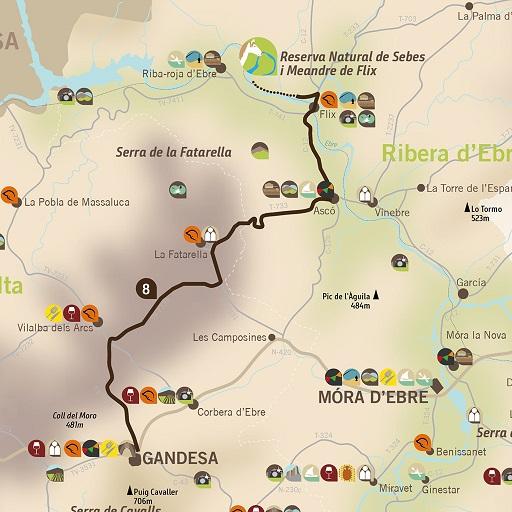Route 8. From Gandesa to Sebes Nature Reserve
Departure point: Gandesa
Duration: full day
Route by car: 36,6 km
Route on foot: 300 m
Circular: no
Gandesa, known for the quality of its Terra Alta Densignation of Origin wines, is the starting point for this route. From there, take the TV-7231 road towards Vilalba dels Arcs, crossing large areas of vineyards with small patches of pine forest. In this area you should see species from Mediterranean environments such as bee-eaters, woodchat shrikes or the more rare greater short-toed lark which is still present in some places with vegetation reminiscent of fallow land. Then, head towards La Fatarella, following the TV-7333 road, on the way, you will see some small bridges where the strange nests of red-rumped swallows are located. Carry on, heading down towards the banks of the Ebro river at Ascó. This is home to black kites along the riverbeds, and black-eared wheatears near the farmhouses and the edges of fields.
Arriving at the C-12, head north going through the town of Flix. As soon as you cross the majestic bridge over the Ebro river, turn left towards Sebes Nature Reserve, where you will find one of the most important natural spaces in the north of Terres de l'Ebre, upstream of the Flix meander. The space has several elevated walkways that allow us to enter the wetlands. Here, you will find different observatories so that you can observe the fauna up close. With the continuous summer song of the golden oriole, you can enjoy watching the little bittern, kingfisher or white storks, the result of a reintroduction project. You must pay attention to the trees throughout the spring when you can discover the most elaborate nests of European ornithofauna, the nest of the penduline tit. After reproduction, this small bird moves towards the best preserved reedbeds looking for small seeds, which are the basis of its diet.
Another mythical bird, the bittern, hides in these reed beds, making it one of the best natural spaces in the region where it can be observed and photographed. In migratory periods, the floodplain meadows, where eleven Camargue horses live and make areas with less vegetation cover a good place to see the hidden spotted crake and little crake.
But not all the wealth is in the wetlands, looking at the slopes and rock faces in the area we can see birds of a more rupicolous nature such as the black wheatear, rock sparrow or blue rock thrush.
Phenology:
Any time of the year is good to visit this area, but if you want to try your luck with the bittern, you will have to come between November and March. Bee-eaters, rollers and woodchat shrikes add bright colours to the dry fields and vineyards from late spring to mid-summer.
Track GPX
We also make the route file available to you in gpx format so that you can use it with your GPS device (see link in the header).






